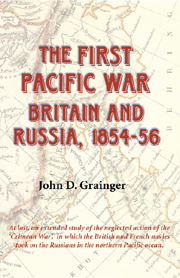Book contents
7 - The Amur Estuary
Published online by Cambridge University Press: 12 September 2012
Summary
Governor-General Muravev planned a second expedition down the Amur River for 1855. He sent a note to Peking to that effect on 2 March. No doubt he was much encouraged by the success of his expedition of the previous year, and by the successful defence of Petropavlovsk, which had been largely due to the soldiers he had sent there from the Amur in August. The Russian position at the Amur had thus, to some extent, proved its value even in 1854. He set 28 April as the date on which the expedition was to sail.
This new voyage was to comprise a much larger company than that of the previous year, and was to be divided into three successive sections. Muravev would conduct the first himself, consisting of twenty-six barges carrying half a battalion of Cossacks; the second group, of fifty-two barges, would carry the 15th Line Battalion; the third, with thirty-five barges, would have on board half of the 14th Line Battalion. All these units would be accompanied by the wives and children of the soldiers, and by cattle and horses, and would carry with them supplies and ammunition. For Muravev, perhaps the most important part of the cargo was forty heavy guns, made in the Ural iron foundries in the past year and moved with infinite effort all the way across Siberia. Loading them onto the rather fragile barges was not easy.
- Type
- Chapter
- Information
- The First Pacific WarBritain and Russia, 1854–56, pp. 138 - 160Publisher: Boydell & BrewerPrint publication year: 2008



